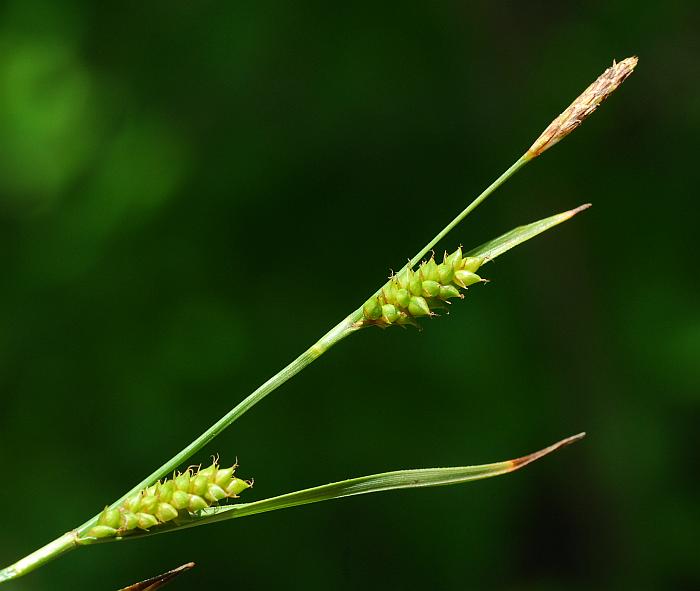Carex crawei Dewey
Crawe's Sedge

Native
CC = 10
CW = 3
MOC = 29
© SRTurner
Carex crawei DeweyCrawe's Sedge | |
 |
Native CC = 10 CW = 3 MOC = 29 |
© SRTurner |
|
Family - Cyperaceae Habit - Sedge with long rhizomes, forming loose colonies of tufts.
Stems - Flowering stems 10-30 cm long, usually stiffly erect, mostly longer than the leaves, bluntly trigonous, mostly smooth, brownish tinged at the base. Leaves - Leaf blades 10-25 cm long, 1-3 mm wide, thick, often arched outward or curled. Leaf sheaths shallowly convex at the tip, glabrous, the ventral side thin, papery, and white, the ligule longer than wide, the lowermost sheaths brownish tinged at the base.
Spikes - Staminate spike 10-25 mm long, with a long, roughened stalk, overtopping the uppermost pistillate spike and usually also the bracts. Staminate scales 3.6-4.2 mm long, rounded to bluntly pointed at the tip. Pistillate spikes 2-4, loosely spaced nearly the entire length of the stem, 10-30 mm long, 4-6 mm wide, sessile or with short, roughened stalks. Pistillate scales 1.2-2.8 mm long, broadly ovate, mostly sharply pointed at the tip, reddish brown with green midrib and tan to white margins.
Perigynia - Perigynia ascending, 2.5-3.5 mm long, ovate to elliptic in outline, tapered abruptly to a very short, inconspicuous beak that is truncate at the tip, the surface with finely raised nerves, green to yellowish green.
Fruits - Achenes 1.7-2.1 mm long, the minute beak erect or slightly bent. Flowering - April - June. Habitat - Calcareous glades. Origin - Native to the U.S. Lookalikes - C. meadii; broadly, many other sedges. Other info. - This inconspicuous little sedge is one of a relatively small number which occur on glades. In Missouri it is found mostly in counties near the southern border, and also in a broad band extending westward from the east-central portion of the state. Beyond Missouri its distribution is unusual, consisting of numerous disjunct populations mostly within the northern 2/3 of the continental U.S., and also ranging into Canada. It is one of the easier sedges to identify, due to its unusual habitat, short stature, and long-stalked staminate inflorescence. Photographs taken at Valley View Glade Natural Area, Jefferson County, MO, 5-20-2019, and Shaw Nature Reserve, Franklin County, MO, 5-5-2021 (SRTurner). |